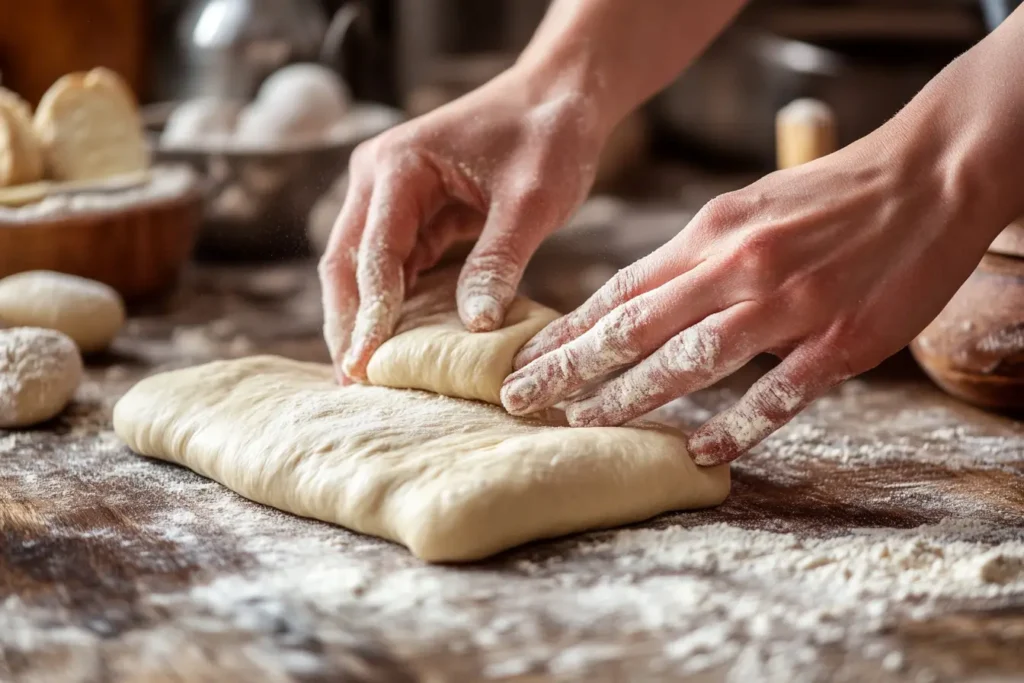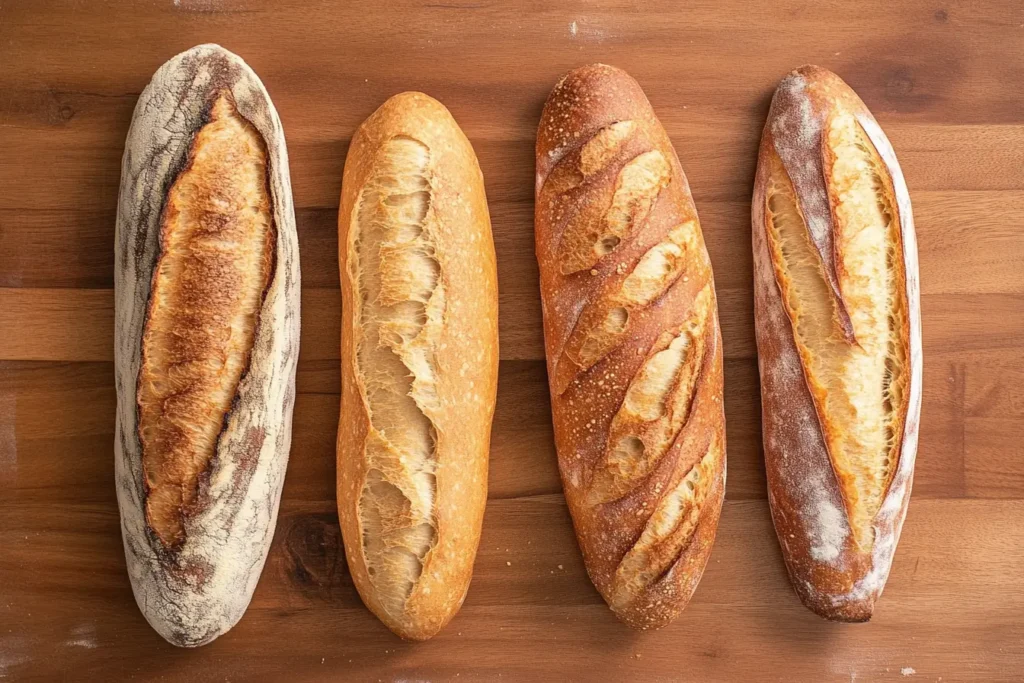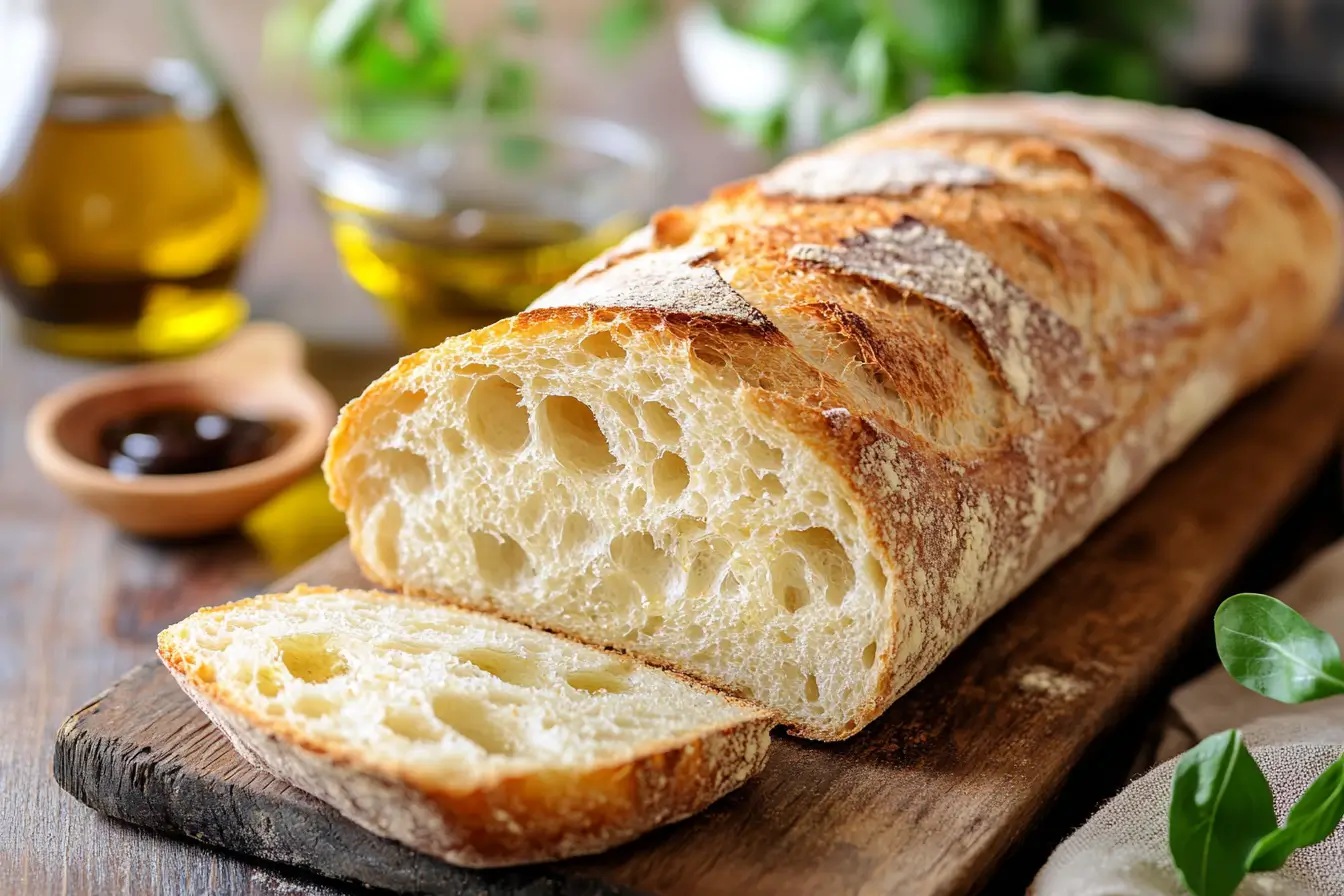Table of Contents
Introduction
When you think of a baguette, your mind probably jumps straight to the classic French loaf with its crispy crust and airy interior. But did you know that Italy has its own version of this beloved bread? The Italian baguette, also known as Stirato, offers a rustic take on the traditional baguette. Unlike its French counterpart, Stirato is made using a no-knead technique, resulting in a crisp crust and a chewy, open crumb.
In this article, we’ll dive deep into the world of Italian baguettes. We’ll explore their history, how they compare to French baguettes, their unique characteristics, and how you can bake one at home. We’ll also cover different ways to enjoy them, from classic sandwiches to perfect pairings with Italian dishes. If you love artisan bread or want to expand your baking skills, this guide is for you!
Now, let’s begin by understanding what makes an Italian baguette special.
What is an Italian Baguette?
Origins and History of Stirato
The Italian baguette, or Stirato, literally means “stretched” in Italian, a name that perfectly describes the way this bread is shaped. Unlike traditional baguettes, which are carefully shaped by hand, Stirato is made by stretching the dough without excessive handling, allowing it to develop its characteristic rustic appearance.
This bread has its roots in Italy’s long-standing tradition of artisan bread baking. While France popularized the baguette, Italian bakers adapted the concept using their own methods and ingredients. Stirato is typically made with just four ingredients—bread flour, water, yeast, and salt—yet it delivers an incredible depth of flavor.
Italian Baguette vs. French Baguette – Key Differences
At first glance, you might mistake an Italian baguette for a French one. However, several differences set them apart:
- No Kneading Required – French baguettes involve intensive kneading, while Stirato follows a no-knead method, allowing for a more relaxed, open crumb.
- More Hydration – Stirato has a higher water content, making it slightly softer inside with a crisp yet delicate crust.
- Shaping Technique – French baguettes are meticulously shaped with a rolling motion, while Italian baguettes are simply stretched into shape.
- Flavor Profile – Thanks to the long fermentation process, Stirato has a complex, slightly tangy flavor compared to the milder taste of a French baguette.
How Italian Baguettes Fit Into Italian Cuisine
In Italy, bread is more than just an accompaniment—it’s an essential part of the meal. While ciabatta and focaccia are well-known Italian breads, Italian baguettes have carved out their own niche. They are perfect for:
- Making Classic Italian Sandwiches – Stuff them with prosciutto, fresh mozzarella, and sun-dried tomatoes for an authentic Italian bite.
- Serving with Soups and Salads – A piece of Italian baguette pairs beautifully with minestrone or panzanella salad.
- Bruschetta and Antipasto Platters – Sliced Stirato makes an excellent base for bruschetta, drizzled with olive oil and topped with fresh tomatoes and basil.
This rustic bread embodies the simplicity and excellence of Italian baking. But what exactly makes an Italian baguette so special? Let’s find out in the next section!
The Unique Characteristics of Italian Baguettes
Crispy Crust and Chewy Interior – The Perfect Texture
One of the defining traits of an Italian baguette is its incredible texture. Unlike a French baguette, which has a more uniform crumb, Stirato boasts an airy, open interior with a slightly chewy bite. The crust is crisp but not overly hard, making it easier to eat without excessive crunch.
The secret to achieving this perfect balance lies in the high hydration level of the dough. A higher water content creates a softer inside while still allowing the crust to crisp up beautifully in the oven. The long fermentation process also contributes to the final texture, developing gluten structure naturally without the need for kneading.
Flavor Profile – What Makes It Distinct from Other Breads?
The Italian baguette has a more complex and slightly tangy flavor compared to its French cousin. This depth of taste comes from the slow fermentation process, which allows the yeast to develop rich, aromatic notes. Some bakers enhance the flavor by using a pre-ferment (like a biga or poolish), giving the bread a slightly nutty undertone.
Another factor that sets it apart is its simple ingredient list. Since it doesn’t contain additives or sugars, the focus remains on the natural flavors of flour, water, yeast, and salt. When baked correctly, the result is a loaf with subtle sweetness, a mild tang, and a satisfying depth that pairs well with both savory and sweet toppings.
Now that we understand what makes an Italian baguette so special, let’s explore how you can make one at home.
How to Make an Italian Baguette at Home

Essential Ingredients for Stirato
To make an authentic Italian baguette, you only need a handful of ingredients:
- Bread flour – Provides the structure and strength needed for a chewy crumb.
- Water – The high hydration level helps create an airy, light texture.
- Salt – Enhances the flavor and regulates yeast activity.
- Instant yeast – A small amount is enough, thanks to the long fermentation time.
Since this is a no-knead recipe, time is the main ingredient that develops the structure and flavor of the dough.
Step-by-Step Guide to Mixing and Fermenting the Dough
- Mix the Ingredients – In a large bowl, combine bread flour, salt, and instant yeast. Gradually add water, stirring until all the flour is hydrated. The dough will be sticky, but that’s expected.
- First Fermentation – Cover the bowl with plastic wrap and let it sit at room temperature for 12 to 18 hours. During this time, the yeast ferments slowly, building flavor and structure.
- Stretch and Fold – Every few hours, gently stretch the dough and fold it over itself to encourage gluten development. This replaces traditional kneading.
Shaping and Stretching – The Art of the Rustic Baguette
- Divide the Dough – Once fully fermented, turn the dough onto a floured surface and divide it into equal portions.
- Shape the Loaves – Instead of rolling the dough tightly (like a French baguette), simply stretch each portion into a long, rustic loaf.
- Second Rise – Let the shaped loaves rest for 30-45 minutes before baking. This allows the gluten to relax, ensuring a light, airy texture.
Baking Techniques for a Crispy, Golden Crust
- Preheat the Oven to 475°F (245°C) – Place a baking stone or an inverted baking tray inside to heat up.
- Create Steam – Place a pan of hot water in the oven or spray the loaves with water before baking. Steam helps create a crispy crust.
- Bake Until Golden – Transfer the loaves to the hot baking surface and bake for 20-25 minutes or until they develop a golden-brown crust.
Once cooled, your homemade Italian baguette will be crisp on the outside, soft inside, and full of rich, fermented flavors. Whether enjoyed fresh, toasted, or as a sandwich, this bread is a game-changer in home baking!
Variations of Italian Baguettes and Related Italian Breads
Ciabatta – A Close Cousin of the Italian Baguette
While the Italian baguette is known for its rustic, stretched shape, another Italian bread with a similar airy interior is ciabatta. Unlike Stirato, ciabatta has a slightly flatter, slipper-like shape (hence its name, which means “slipper” in Italian).
The main difference between these two breads lies in their texture and hydration levels. Ciabatta dough is extremely wet, often containing over 80% hydration, giving it a chewy texture with large, irregular holes. Unlike Stirato, which relies on minimal handling, ciabatta is often folded multiple times to develop structure.
Both breads share a light, open crumb and crispy crust, making them excellent choices for sandwiches, bruschetta, or dipping into olive oil and balsamic vinegar.
Pane Rustico – A Heartier Alternative
For those who love rustic, hearty bread, Pane Rustico is an excellent alternative to the Italian baguette. This traditional Italian country bread is often made with a mix of bread flour and whole wheat flour, giving it a slightly denser texture and a nutty flavor.
The fermentation process for Pane Rustico is similar to that of Stirato, relying on a long, slow rise to develop deep flavors. This bread is perfect for pairing with hearty soups, cheeses, and cured meats.
Schiacciata and Other Regional Italian Bread Varieties
Schiacciata, a Tuscan flatbread similar to focaccia, is another must-try variation. Unlike the Italian baguette, which has a crisp crust and airy crumb, schiacciata is typically soft and chewy, brushed with olive oil, herbs, and sometimes topped with grapes or onions.
Italy is home to a vast variety of regional breads, from Pugliese bread with its thick crust to Filone, a long rustic loaf similar to a baguette. Each type showcases Italy’s deep-rooted baking traditions, offering something unique for every bread lover.
Now that we’ve explored different Italian breads, let’s move on to the best ways to enjoy an Italian baguette.
Best Ways to Enjoy an Italian Baguette

Classic Italian Baguette Sandwiches
One of the best ways to savor an Italian baguette is by turning it into a delicious sandwich. Thanks to its crispy crust and soft, chewy interior, it holds up beautifully to a variety of fillings. Some classic Italian sandwich ideas include:
- Prosciutto & Mozzarella – Layer fresh mozzarella, thinly sliced prosciutto, and a drizzle of extra virgin olive oil.
- Caprese-Style Sandwich – Fresh basil, tomatoes, and buffalo mozzarella with balsamic glaze.
- Salami & Pecorino – A bold combination of Italian salami, pecorino cheese, and arugula for a peppery bite.
Pairing with Soups, Dips, and Spreads
A fresh Italian baguette is perfect for dipping. Whether you’re serving it alongside a comforting soup or a flavorful spread, its crusty exterior and soft interior make it the ideal companion. Here are a few pairing ideas:
- Minestrone Soup – A slice of warm Italian baguette complements the rich flavors of this hearty Italian soup.
- Tomato & Basil Bruschetta – Toasted Stirato slices topped with diced tomatoes, garlic, and fresh basil.
- Olive Tapenade – Spread this briny, flavorful mix of olives, capers, and garlic onto warm baguette slices.
Using Italian Baguettes for Bruschetta and Appetizers
Another great way to use an Italian baguette is by making bruschetta or crostini. These classic Italian appetizers are easy to prepare and bursting with flavor. Simply slice the baguette, toast the pieces, and top them with ingredients like:
- Ricotta & Honey – A delightful mix of creamy ricotta cheese and a drizzle of honey.
- Roasted Peppers & Goat Cheese – A tangy, smoky combination.
- Garlic & Herb Butter – Simple, yet incredibly delicious when served warm.
Whether you’re making a sandwich, appetizer, or simply enjoying it with butter, the Italian baguette is an incredibly versatile bread.
Italian Baguette in Modern Baking Trends
How High-Hydration Dough Improves Texture
One of the biggest trends in artisan bread baking today is high-hydration dough, and the Italian baguette fits right into this movement. By increasing the water content, bakers achieve a softer, airier crumb with larger holes. This technique not only improves texture but also enhances the natural flavors that develop during fermentation.
High-hydration doughs require gentle handling rather than heavy kneading. The stretch-and-fold method, commonly used for Stirato, helps build gluten strength without overworking the dough. This results in a perfectly chewy inside with a delicate, crispy crust—a hallmark of an authentic Italian baguette.
Experimenting with Sourdough Starters for Deeper Flavor
Another modern trend influencing the Italian baguette is the use of sourdough starters instead of commercial yeast. A natural starter not only adds depth to the flavor but also improves digestibility and shelf life. The longer fermentation process breaks down gluten, making the bread easier to digest.
Many home bakers and professionals alike are now experimenting with hybrid doughs, combining a small amount of yeast with sourdough starter for the best of both worlds. Whether using a starter or instant yeast, the Italian baguette continues to evolve while maintaining its rustic charm.
FAQs About Italian Baguettes

What makes Italian baguettes different from French baguettes?
The biggest differences lie in shaping, hydration, and fermentation. An Italian baguette (Stirato) is stretched rather than rolled, has higher hydration, and often undergoes a no-knead, long fermentation process, creating a rustic, airy crumb. French baguettes are more uniform in shape and have a crispier, thinner crust due to traditional shaping and scoring techniques.
Can I make an Italian baguette without a bread machine?
Absolutely! The Italian baguette is one of the easiest artisan breads to make at home because it requires no kneading or special equipment. You just need a bowl, a baking tray, and an oven. With a long fermentation and a simple stretch-and-fold technique, you can achieve bakery-quality results right in your kitchen.
How do you store an Italian baguette to keep it fresh?
To keep your Italian baguette fresh, store it in a paper bag at room temperature for up to two days. Avoid plastic bags, as they trap moisture and make the crust soggy. If you need to store it longer, freeze it in an airtight bag and reheat in the oven for a crisp crust.
What are some common mistakes when making Italian baguettes?
Some common pitfalls include using too much flour, not letting the dough ferment long enough, or overhandling the dough before baking. Since Italian baguettes rely on a high-hydration, no-knead method, it’s important to let the dough rest properly and handle it gently for the best texture.

Italian Baguette – Rustic No-Knead Bread Recipe
- Total Time: About 19 hours (including overnight fermentation)
- Yield: 2 baguettes 1x
Description
This Italian baguette, also known as Stirato, is a no-knead, high-hydration bread with a crispy crust and a light, airy crumb. Perfect for sandwiches, bruschetta, or simply enjoyed with olive oil and balsamic vinegar!
Ingredients
For the Dough:
- 3 ½ cups (440g) bread flour
- 1 ½ cups (360ml) warm water (about 100°F / 38°C)
- 1 ¼ teaspoons salt
- ½ teaspoon instant yeast
For Baking:
- ¼ cup semolina flour or cornmeal (for dusting)
- ½ cup hot water (to create steam in the oven)
Instructions
- Mix the Dough – In a large bowl, whisk together the bread flour, salt, and instant yeast. Gradually add warm water while stirring with a wooden spoon until a sticky dough forms.
- First Rise (12-18 Hours) – Cover the bowl with plastic wrap and let the dough ferment at room temperature overnight (12-18 hours) until it doubles in size and becomes bubbly.
- Shape the Baguettes – Lightly flour a work surface and gently turn out the dough. Avoid deflating it too much. Cut into two equal pieces and carefully stretch each into a long, rustic shape (about 12 inches long).
- Second Rise (45 Minutes) – Place the shaped baguettes on a parchment-lined baking sheet dusted with semolina flour. Cover loosely with a kitchen towel and let them rest for 45 minutes.
- Preheat the Oven to 475°F (245°C) – Place a baking stone or an inverted baking sheet inside. Position a small baking dish with ½ cup of hot water on the lower rack to create steam.
- Bake Until Golden – Transfer the baguettes onto the hot baking surface and bake for 20-25 minutes, or until they are golden brown with a crisp crust.
- Cool & Enjoy – Allow the baguettes to cool on a wire rack for at least 30 minutes before slicing. Enjoy with olive oil, butter, or as a sandwich base!
Notes
- For a more complex flavor, use a biga (pre-ferment) by mixing ½ cup flour, ¼ cup water, and a pinch of yeast, letting it sit overnight before adding it to the dough.
- If you prefer a darker, crunchier crust, spray the baguettes with water before baking.
- Store at room temperature in a paper bag for up to 2 days, or freeze for up to 1 month.
- Prep Time: 15 minutes
- Cook Time: 25 minutes
- Category: Lunch
- Cuisine: Italian
Nutrition
- Calories: 180
- Sugar: 0g
- Fat: 1g
- Carbohydrates: 36g
- Protein: 6g
Keywords: Italian baguette, Stirato bread, no-knead baguette, rustic bread, artisan bread, homemade Italian bread, crispy baguette

